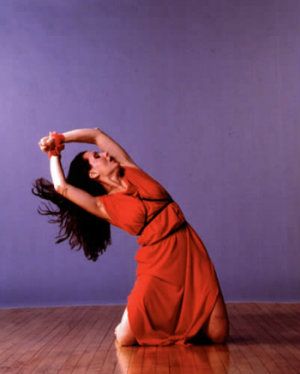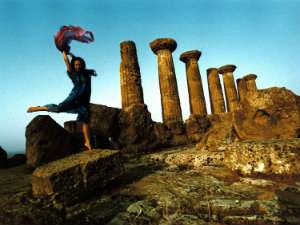
By Robert Burke Warren
This Mother’s Day weekend, two deeply devoted dance organizations combine their resources, offering audiences a chance to celebrate life, love, beauty, and the feminine energy that brought us all here. Kaatsbaan International Dance Center in Tivoli hosts the Isadora Duncan International Institute Dancers’ From Isis to Isadora on Saturday, May 11 and Sunday, May 12, honoring the vision of the “matriarch of modern dance,” Isadora Duncan. (Photo montage and rare video here, picture of her above.) With the estimable Jeanne Bresciani at the helm, the IDII carries on the work, in Duncan’s own words, of creating a “luminous manifestation of the soul,” and Kaatsbaan, a 153-acre historic site nestled on verdant farmland formerly owned by the Roosevelts, is a thriving dance mecca, with a Metropolitan Opera-sized stage, yet only 180 seats.
 Doyenne of dance Bresciani is directly linked to Isadora Duncan, and overflows with enthusiasm when discussing her art, and the upcoming performance, which will include 23 dancers. “I was taught by Isadora’s adopted daughter (and IDII co-founder) Maria Theresa Duncan herself,” she says. “She was passionate, radiant; she danced ‘til she was 90 years old. She was called the last dancing “Isadorable.” She’s a woman who, in a particular year, danced a Carnegie Hall solo concert, had a baby that summer, then another baby that December. A real woman.”
Doyenne of dance Bresciani is directly linked to Isadora Duncan, and overflows with enthusiasm when discussing her art, and the upcoming performance, which will include 23 dancers. “I was taught by Isadora’s adopted daughter (and IDII co-founder) Maria Theresa Duncan herself,” she says. “She was passionate, radiant; she danced ‘til she was 90 years old. She was called the last dancing “Isadorable.” She’s a woman who, in a particular year, danced a Carnegie Hall solo concert, had a baby that summer, then another baby that December. A real woman.”
The fearless, revolutionary Duncan could not have chosen a more fitting apostle than Bresciani to carry her vision into the 21st century. Duncan’s style was — and is — rooted not only in movement, but also in philosophy, particularly the philosophy of the Greeks. True to that, Dr. Bresciani (she’s a Ph.D and an MA), who cataloged the self-taught Duncan’s extensive library, infuses performances (and conversation) with allusions to Rilke, Sappho, Rumi, Jung, Plato, and Da Vinci, among others, all of whom sought, like Duncan, to illuminate the soul.
 “From Isis to Isadora,” Bresciani says, “draws inspiration from myth. Everything I do comes from myth. Mythos is the glue that holds the culture together.” The Isis myth, one of the great “mother goddess” myths of the ages, particularly inspires Bresciani as a potent, timeless story for modern-day audiences, who come to performances from an increasingly fractured world. In the Isis myth, the goddess restores her husband/brother Osiris, who has been dismembered by the jealous god Set and strewn about Egypt, so that they may produce Horus, the “last god,” the god of the sky. “We’re such a fragmented people,” Bresciani says. “We need the myth of Isis, where she’s gathering the parts of the beloved Isis and Osiris together, creating, forging the last god, without whom there would be no progeny, no divine race of beings. We must gather the fragments of the great creation of the eternal material that never dies, never goes away. That’s why I do the work I do, and why I do it the way I do it, rather than just teaching steps. You add Shakespeare to it, you add Ovid and Dante, and we have a world that never dies.”
“From Isis to Isadora,” Bresciani says, “draws inspiration from myth. Everything I do comes from myth. Mythos is the glue that holds the culture together.” The Isis myth, one of the great “mother goddess” myths of the ages, particularly inspires Bresciani as a potent, timeless story for modern-day audiences, who come to performances from an increasingly fractured world. In the Isis myth, the goddess restores her husband/brother Osiris, who has been dismembered by the jealous god Set and strewn about Egypt, so that they may produce Horus, the “last god,” the god of the sky. “We’re such a fragmented people,” Bresciani says. “We need the myth of Isis, where she’s gathering the parts of the beloved Isis and Osiris together, creating, forging the last god, without whom there would be no progeny, no divine race of beings. We must gather the fragments of the great creation of the eternal material that never dies, never goes away. That’s why I do the work I do, and why I do it the way I do it, rather than just teaching steps. You add Shakespeare to it, you add Ovid and Dante, and we have a world that never dies.”
The program “also includes a waltz of someone who is getting the energy of the ancient world and doesn’t know where it’s coming from, and drops out of the ballet and finds something freer and looser; then we have the Olympian, a depiction of twelve tiny little sketches of the ancient Olympic events; we have In Her Garden, a paean to nature and beauty and freedom, then Roses From the South, an Isadora dance set to a famous Strauss waltz.” The barefoot dances include all the trademark Duncan elements: fluid movement, skipping, flowing scarves (of course), and exuberant, faun-like leaps.
How do audience members new to Isadora Duncan’s style react after an IDII performance? Says Bresciani: “People say, ‘It’s what I always dreamed dance was but never saw before on a stage.’ It’s the dance ‘the people’ love. It’s not necessarily the dance of the intellectual, it’s not edgy, it doesn’t break things apart, it doesn’t deconstruct things, it doesn’t leave you hanging. Isadora was always about the triumph of the human spirit. Something is resolved in beauty… you’re never left thwarted or undone. I may die onstage, but it’s a triumphant, ecstatic death. It is for a purpose, for a reason, everything is endowed with a passionate cause; there is nothing gratuitous. There is no movement that doesn’t have a meaning.”
For anyone tired of chaos — and who isn’t? — From Isis to Isadora, at idyllic, rustic-yet-state-of-the-art Kaatsbaan, offers a reprieve like a mother’s warm embrace, the enduring vision of a modern-day goddess.
From Isis to Isadora: The Ancient and Eternal Ideal in Art
Saturday, May 11, 7:30 p.m.
Sunday, May 12, 2:30 p.m.
Adults, $30; children, $10
Kaatsbaan
120 Broadway, Tivoli, NY
